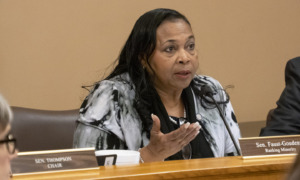
Aksinia Abiagam/Shutterstock
.
Over the past two decades, I have had the extraordinary experience of working with youth involved in the juvenile justice system and the child welfare system. I am thrilled to bear witness as Los Angeles County finally moves toward using diversion programs to keep kids out of juvenile justice and in school and at home where they belong.
However, as a strong proponent of diversion, and restorative justice in particular, it is alarming to know that youth in the child welfare system are often kept out and left out of diversion programs for reasons beyond their control. As anyone following trauma-informed practices can attest, children who have experienced the trauma of abuse and neglect should be the first to have the option to participate in diversion, certainly not the last.
Unfortunately, as is the case in so many aspects of their lives, youth living in foster care and congregate care in LA County have additional obstacles to participating in diversion programs when they commit a crime or come in contact with law enforcement. In fact, youth in foster care are over-represented at nearly every stage in the criminal justice process. The reasons are both simple and complicated, but fortunately are at the top of mind of many child welfare leaders working to find solutions.
Here is my take on why this problem exists and what to do about it.

Wende Julien
Before becoming CEO of Court Appointed Special Advocates (CASA) of Los Angeles, I worked at an awesome organization called the California Conference for Equality and Justice (CCEJ) that trains teens in human relations and provides restorative justice programs that allow youth to be diverted from the juvenile justice system. One afternoon, CCEJ staff were conducting a leadership and human relations course for a group of teen girls incarcerated at Los Padrinos Juvenile Hall. The exercise they were doing is one of my favorites: It’s called “Personal Timeline.” The girls use crayons and markers to create an artistic rendition of how they got to where they are now. Young people often bring up highlights and lowlights of their lives while doing this exercise, things like the birth of a sibling, the death of a grandparent, moving to a new school, etc.
No caregiver, no advocate
What struck me that day in Los Padrinos was a common theme that every one of the girls included in their timeline: their experience as a victim of physical abuse, sexual abuse or neglect as a child.
According to research recently published by the Children’s Data Network out of the University of Southern California, this result was not an anomaly. In fact, four in five, or 80%, of children in our juvenile halls and camps have a history with the child welfare system. In effect, we are locking up victims of child abuse and neglect, even when we know that the trauma they have experienced is often the cause of their “criminal” behavior.
This experience at Los Padrinos was a motivating factor for me to come to work at CASA. It was a chance to move upstream — to work in the child welfare system where children are still considered victims rather than perpetrators. Or so I thought. I was also motivated by the scope of the system — 30,000 children and teens with open cases of abuse, neglect and abandonment.
So why are victims of abuse and neglect over-represented in the juvenile justice system and kept out or left out of diversion? The simple answer is that they often lack a parent or caregiver who can advocate for them to be diverted.
It works like this: Years ago when my teenage child was stopped by police for engaging in a dumb, stereotypical teenage act, she was transported to the police station. Among the first things they asked was for her parent’s phone number. I answered the phone, showed up at the police station as a white mom with a law degree and a stern face clearly ready to address this bad behavior when we got home. Not surprisingly, my daughter left the station that night with a ticket for a minor offense (curfew violation) when the actual charges could have been quite severe.
What, though, would have been the outcome for a teenager who had to respond to the officer that their parent was incarcerated or didn’t have custody of them or their whereabouts were unknown? What if the “parent” was a group home where the answer was that the officer should call DCFS (the Department of Children and Family Services) or was a foster parent who refused to come pick the child up?
The answer: much more likely that the child would be arrested, booked, and the case referred to probation and potentially adjudication. Much less likely the child would go home that night. Recently, one of our developmentally disabled CASA teens spent the night in jail after a minor altercation with someone in her group home where no one was injured. Why? Because no one would pick her up.
Solutions exist
From the initial contact with law enforcement, teens in foster care have a disadvantage and are less likely to be diverted. That also continues through the process, since most diversion programs, including restorative justice, want the teen to have an adult (usually a parent) sign off on their participation and agree to ensure that they will have transportation to the program and support in completing the terms of diversion.
This is a problem that needs (and has) immediate solutions. First, law enforcement needs to be engaged and trained to recognize this issue so they can treat teens in foster care with a trauma-informed lens that favors leniency and recognizes that the lack of a parent or caregiver should not be a reason to enforce laws against a child who would otherwise be let go. Fortunately, many law enforcement departments around LA County are engaging in this type of training but it needs to be enforced countywide.
Second, probation, law enforcement agencies and community-based agencies need to actively work to engage youth in foster care in diversion programs. If the youth needs a caring adult to accompany them through the process, that’s where we come in. We are actively training Court Appointed Special Advocates (CASA volunteers) to serve in this role and are ready to help young people all over the county successfully complete diversion and move on without a criminal record.
The goal: Youth in foster care should have MORE access to leniency and diversion than youth not in foster care. Together we can make that happen.
Wende Julien is the CEO of CASA of Los Angeles, a community-supported 501(c)(3) nonprofit organization that recruits, trains and supports volunteers who work one-on-one with children in LA County who have suffered from serious cases of abuse or neglect. CASA volunteers work closely with a child to form a trusting relationship and help the child to thrive.





























